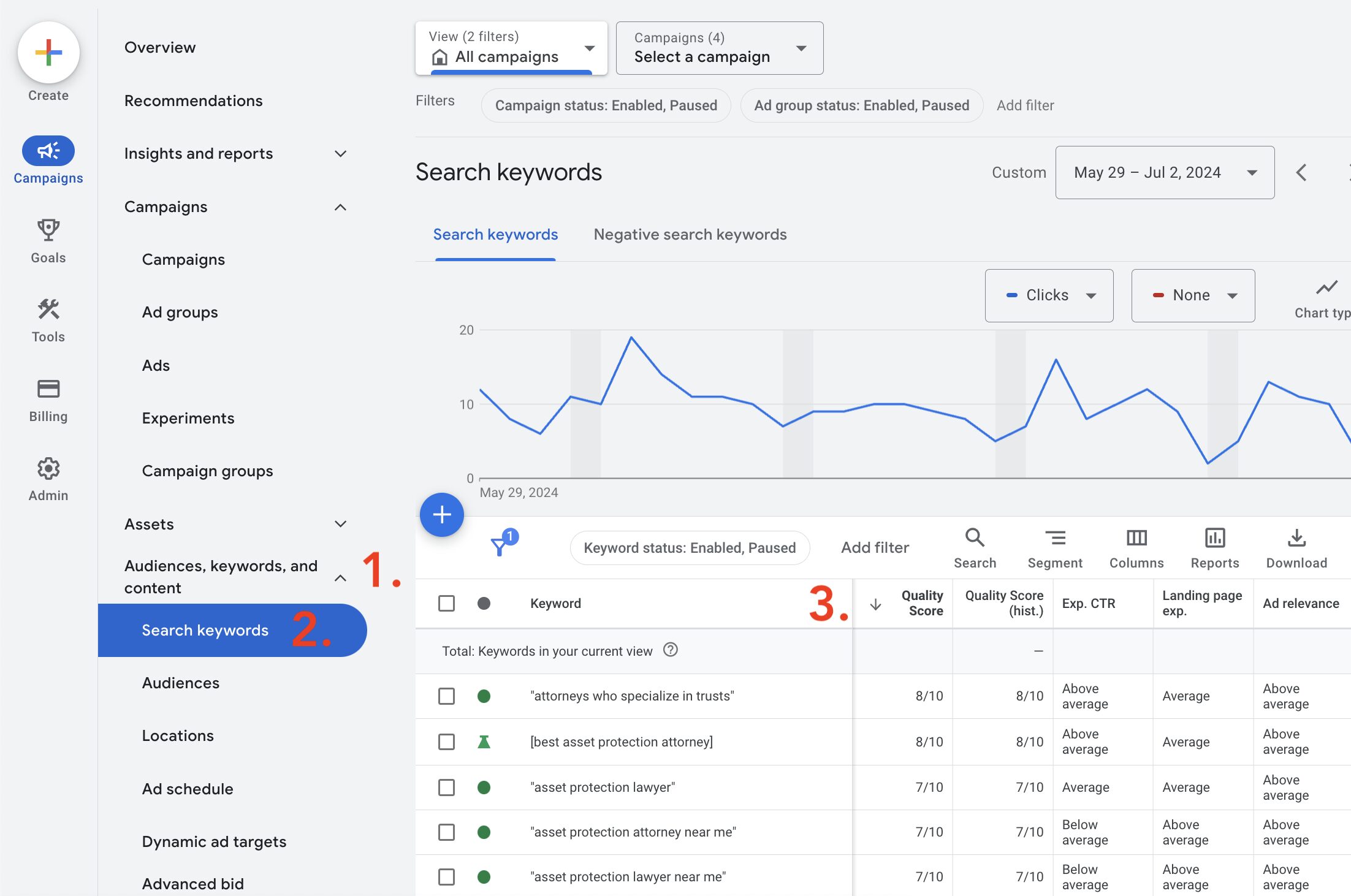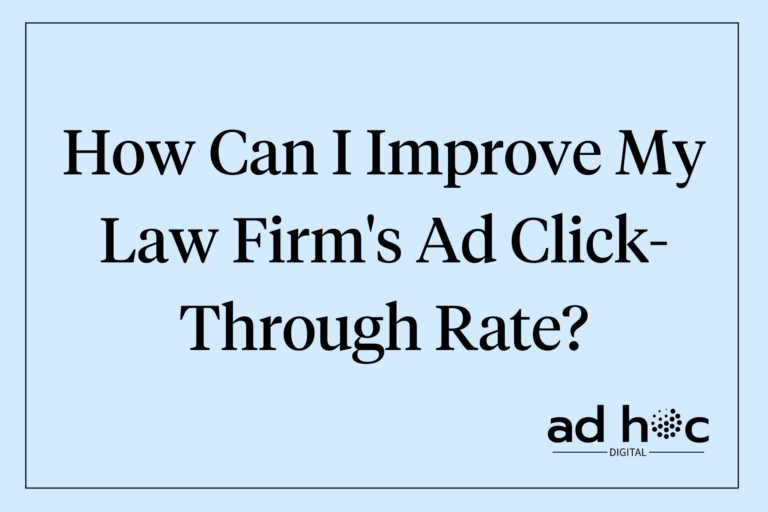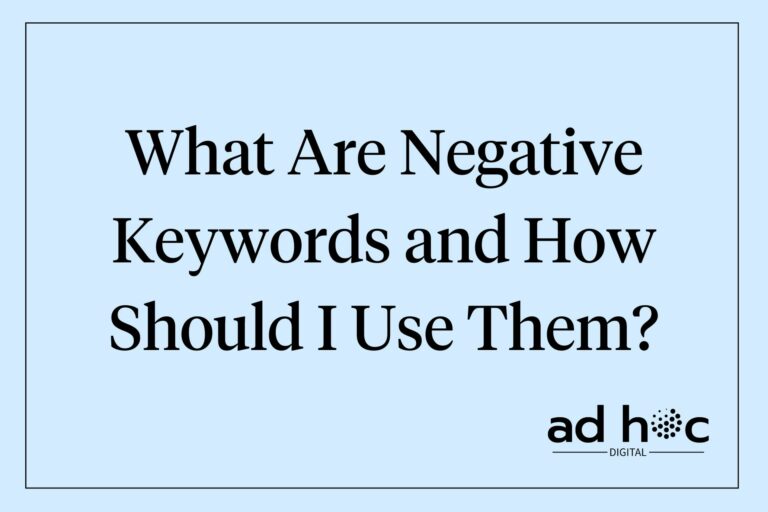Understanding Quality Score is essential for law firms looking to maximize their Google Ads effectiveness.
Quality Score plays a crucial role in determining how your ads perform, their position on the search results page, and the cost per click. Because of this, if you don’t want to engage in bidding wars to end up at the top of the Google search results page, this is something you are going to want to get right.
In this detailed guide, we will cover what Quality Score is, why it is important for law firms, and how you can practically improve it.
For deeper insights into crafting successful campaigns, explore our guide on effective Google Ads strategies for lawyers.
Understanding Quality Score
Definition
Quality Score is a metric used by Google to measure the relevance and quality of your ads, keywords, and landing pages. It is scored on a scale from 1 to 10, with 10 being the highest. A high Quality Score indicates that your ad and landing page are highly relevant to the user’s search query.
According to Google themselves, “Quality Score is a diagnostic tool meant to give you a sense of how well your ad quality compares to other advertisers.
This score is measured on a scale from 1 to 10 and is available at the keyword level. A higher Quality Score means that your ad and landing page are more relevant and useful to someone searching for your keyword, compared to other advertisers.
You can use the Quality Score diagnostic tool to identify where it might be beneficial to improve your ads, landing pages or keyword selection.”
Components of Quality Score
Quality Score is influenced by three main factors:
- Expected Click-Through Rate (CTR): The likelihood that your ad will be clicked when shown.
- Ad Relevance: How closely your ad matches the intent of the user’s search.
- Landing Page Experience: The quality and relevance of your landing page content.
Importance of Quality Score for Law Firms
- Impact on Ad Rank: Quality Score directly affects your ad rank, which determines the position of your ad on the search results page. Higher ad ranks lead to better visibility and more clicks.
- When you search for something on Google, you probably click on the first result most of the time. Most people do this, which is why the top three paid ads on a Google search results page get about 46% of all clicks. (Web FX)
- Cost Efficiency: A higher Quality Score can significantly lower your cost per click (CPC). Google rewards high-quality ads with lower costs, allowing you to get more value from your advertising budget.
- Ad Performance: Improving your Quality Score enhances your overall campaign performance. High-quality ads attract more clicks and conversions, driving better results for your law firm.
- In our experience, all of our clients’ top performing keywords have had high quality scores and relatively’ lower costs-per-click.
Factors Affecting Quality Score
Expected Click-Through Rate (CTR)
Definition and Importance: CTR is the ratio of clicks to impressions. A higher CTR indicates that your ad is appealing to users.
How to Improve CTR:
- Creating compelling ad copy:
- To create compelling ad copy, you should focus on crafting headlines that grab attention and match the user’s search intent.
- Always use clear, concise language and highlight the benefits or unique selling points of your firm.
- Whenever possible, incorporate numbers, questions, or keywords to make the headline more compelling.
- Your descriptions should be persuasive, clearly stating why your law firm is the best choice and encouraging users to take action with strong calls to action (CTAs).
- For an in-depth guide, see our article on creating effective ad copy for your law firm.
- Utilizing ad extensions:
- Ad extensions enhance your ads by providing additional information and increasing their visibility or real estate on the search engine results page (SERPs).
- You should use sitelinks, callouts, structured snippets, and call extensions to make your ads more informative and engaging.
- Ad extensions can significantly improve your click-through rate (CTR) by offering more opportunities for users to interact with your ad.
- Optimizing the keywords you are targeting:
- Select highly relevant keywords that align with the services you offer.
- To do this, you should conduct thorough keyword research to identify terms potential clients are likely to use.
- You should also use negative keywords to filter out all irrelevant traffic and ensure your ads are shown to the right audience.
- Make sure you regularly review and adjust your keyword strategy based on performance data to keep your ads effective and relevant.
- Targeting the right audience:
- Refine your audience targeting using demographic data to focus on the specific age groups, genders, and income levels that are most relevant to your practice area.
- Use geographic targeting to ensure your ads are shown in locations where your services are available.
- On top of this, you can target specific zip codes with Google Ads. We use this approach to target more affluent areas for our clients with a large minimum retainer in practice areas like estate planning, asset protection, and family law.
- Finally, optimize for different devices by adjusting bids based on performance data to ensure your ads reach the most relevant users effectively.
- See which device functions best for your practice area and location. Do note that this varies significantly, so if you’re in doubt, it’s best to start broad and then make decisions once you have data.
For more tips, see our comprehensive article on improving Google Ads CTR for law firms.
Ad Relevance
Definition and Importance: Ad relevance measures how closely your ad matches the user’s search query. Highly relevant ads are more likely to be clicked.
Strategies to Enhance Ad Relevance:
- Conduct thorough keyword research to align your ads with user intent:
- Start by brainstorming a list of terms related to your services.
- You should use tools like Google Keyword Planner, SEMrush, or Ahrefs to find popular and relevant search terms.
- Note: We normally recommend just sticking to Google’s keyword planner, as it has been the most accurate in our experience.
- Look for keywords with high search volumes but low competition.
- This is often easier said than done. Most of the time, in practice, you will find medium search volume with medium competition. It is super rare to find gems, though it is still possible, so you should still look.
- Regularly update your keyword list based on performance data and industry trends.
- For example, different practice areas have peak client volume during certain times of the year. In these circumstances, you might want to slightly tailor your approach to accommodate this change.
- For more on keyword strategies, read our article on the best keywords for law firm Google Ads.
- Use dynamic keyword insertion to make your ads more relevant to search queries.
- Dynamic keyword insertion (DKI) automatically inserts the keyword that was triggered by a user’s search into your ad copy.
- This customization increases the likelihood that your ad will catch the user’s eye because, often times, it is literally exactly the same as what they searched for.
- Ensure your ad groups are tightly themed so the inserted keywords make sense and your ad copy remains coherent and compelling.
- If they are not, and your keyword match type is too broad, this can have the opposite effect.
- Learn more about dynamic keyword insertion for Google Ads lawyers.
- Write clear and targeted ad copy:
- As you can see, this is the same as the advice to improve your CTR. A lot of the time, the components of the quality score overlap.
- For advice on this, simply refer to the previous section.
- As you can see, this is the same as the advice to improve your CTR. A lot of the time, the components of the quality score overlap.
Landing Page Experience
Definition and Importance: Landing page experience measures the relevance and quality of the landing page that users are directed to after clicking your ad.
Best Practices for Improving Landing Page Experience:
- Ensure that your landing page content is highly relevant to your ad copy and keywords:
- Consistency and Coherence: Make sure the content on your landing page matches the promises made in your ad. If your ad promotes “free consultations for personal injury cases,” the landing page should prominently feature this offer.
- Note: The key to successful Google Ads is coherence. Users hate when they are subjected to bait-and-switch strategies. If users have bad experiences with ads, they are less likely to trust Google Ads, which therefore leads to less revenue for Google. Because of this, Google handsomely rewards consistency.
- Targeted Content: Tailor the landing page to the specific keywords and audience you are targeting.
- If your ad targets “car accident lawyers,” ensure the landing page focuses on car accident legal services rather than general personal injury.
- This approach is often overlooked, most likely because it involves a significant amount of additional work, although it pays off in the long run by improving ad relevance and conversion rates.
- Headlines and Copy: Use headlines and body copy that reflect the keywords and phrases in your ads. This not only improves relevance but also enhances the user’s trust and reduces bounce rates.
- Note: You don’t have to always have an exact match. This is what Google says: “Keep in mind, the word-for-word phrase from a search term doesn’t need to be on your landing page.”
- Consistency and Coherence: Make sure the content on your landing page matches the promises made in your ad. If your ad promotes “free consultations for personal injury cases,” the landing page should prominently feature this offer.
- Optimize page load speed and mobile friendliness:
- Page Load Speed: Users expect fast-loading pages. Tools like Google PageSpeed Insights can help you identify and fix issues that slow down your site. A fast-loading page improves the user experience and can boost your Quality Score.
- Mobile Optimization: Ensure your landing page is fully responsive and works well on all devices, especially mobile. According to Semrush, up to 70% of users access the internet via mobile devices, so a mobile-friendly design is crucial. This includes having easily clickable buttons, readable text without zooming, and a layout that is responsive and adjusts seamlessly to different screen sizes.
- Provide a clear and easy-to-navigate user experience:
- Simplicity: Keep your landing page clean and clutter-free. Remove unnecessary elements that can distract or confuse visitors.
- Some practical examples of this include having multiple floating widgets. I have seen some law firms that have a chat widget, a call widget, and a message widget floating all at once. On top of this, they will have popups after a certain amount of time on the site. Though these strategies can work by themselves, I would still advise you to limit them because they can seriously limit the user experience.
- Navigation: Make navigation intuitive. Use clear calls to action (CTAs) that guide users towards the desired action, whether it’s filling out a form, calling your office, or downloading a resource.
- Visual Hierarchy: Use design principles to draw attention to key areas. Important information, such as your offer and CTA, should be prominently displayed. Use contrasting colors, larger fonts, and strategic placement to highlight these areas.
- Forms and Contact Methods: Ensure that forms are easy to fill out with minimal required fields. Offer multiple contact methods, like phone, email, and chat, to accommodate different user preferences.
- We have found that for every form field we add, our cost per lead increases by about 33% on average. Because of this, we leave the qualification until after the lead has been captured.
- Simplicity: Keep your landing page clean and clutter-free. Remove unnecessary elements that can distract or confuse visitors.
We are big believers in having as much inflow of leads at the top of the funnel, then worrying about the qualification later. A lot of firms limit the throughput of leads in their systems because they restrict the inflow too early in the process.
For more comprehensive strategies, check out our in-depth guide on best practices for Google Ads landing pages for lawyers.
How to Measure and Monitor Quality Score
Accessing Quality Score Data
You can find your Quality Score in your Google Ads account under the “Keywords” tab.
- Click the ‘Audiences, keywords and content’ drop-down in the section menu.
- Click on ‘Search keywords’.
- Then you can scroll and sort the data by quality score.
Alternatively, if you can’t find it in the columns, you need to add it. This is how you do it:
- In the upper right-hand corner of the table, click the columns icon.
- Under “Modify columns for keywords”, open the Quality Score section. To see the current Quality Score and its components, choose the following (our recommendation) to add to your table:
- Quality Score
- Landing Page Experience.
- Expected CTR
- Ad Relevance
- Quality Score (hist.)
- Click Apply.
For eligible keywords, you will have a quality score out of 10, and then you will also be able to see the score for each keyword based on the three components; expected click-through rate, landing page experience, and ad relevance.

Conclusion
Quality Score is a vital metric for law firms using Google Ads. By understanding and optimizing the components of Quality Score, you can improve your ad performance, lower costs, and achieve better results. Regular monitoring and continuous improvement are key to maintaining a high Quality Score.
If you found our content valuable, consider subscribing to our weekly newsletter below for more resources. Also, if you wish to work with us, simply fill out the form below to learn more about our services.
Thank you for reading.



